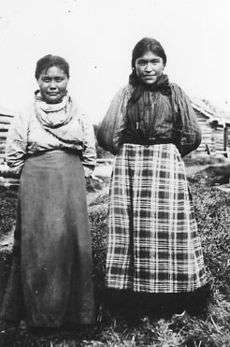Slavey
|
Slavey girls, Mackenzie River, Northwest Territories | |
| Total population | |
|---|---|
|
(Canada Northwest Territories Alberta) | |
| 2,310 (2006)[1] | |
| Languages | |
| English, North and South Slavey language | |
| Religion | |
| Christianity, Animism | |
| Related ethnic groups | |
| Sahtu (North Slavey) |
The Slavey (also Slave) are a First Nations aboriginal people of the Dene group, indigenous to the Great Slave Lake region, in Canada's Northwest Territories, and extending into northeastern British Columbia and northwestern Alberta.
Name
The name is seldom used by the Slavey, who call themselves Dene. Indigenous ethnonyms for South Slavey people and language are Dehcho, Deh Cho Dene (″Mackenzie River People″) or Dene Tha.[2]
Though most Athabaskan peoples call themselves Dene, those in the Northwest Territories tend to mean it for themselves only. However, the northern Slavey are also known in English as the Sahtú, while the southern band are known as the Deh Cho.[3]
The names of the Slave River, Lesser Slave River, Great Slave Lake and Lesser Slave Lake all derive from this Cree name for their enemies, though not necessarily from the people now known as Slavey in English. The term Esclaves remains incorporated in each of these geographical features' French names.
Groups
The South Slavey live in northwestern Alberta, northeastern British Columbia, and the southern Northwest Territories. First Nations of South Slavey people:[4]
- The Dene Tha' First Nation in Alberta. Own name: for people Dene Tha’ or Dene Dháa «ordinary people», for language Dene Dháh. Historical literature by a number of names, including the following: Upper Hay River Band; Hay Lake(s) Band; Hay River Indians; Slave Band; Slavey Indians at Hay Lake(s); Upper Hay River Post Indians; and Bistcho Lake Tribe.
- The Dehcho First Nations (also called Deh Cho Dene - ″Mackenzie River Dene″[5]) in the Northwest Territories:
- Acho Dene Koe First Nation - Fort Liard (Ahcho Koe or Ahcho Kue)
- Deh Gah Gotie Dene Council - Fort Providence (Zhahti Koe or Zhahti Kue)
- Jean Marie River First Nation (Tthe’K’ehdeli Dene) - Jean Marie River (Tthek'éhdélį or Tthek'edeli)
- Katl'odeeche First Nation (Kátłʼodehche Dene[6]) - Hay River (Xátł'odehchee) with Hay River Reserve
- Ka’agee Tu First Nation (Ka’agee Tu Dene)- Kakisa (K'ágee)
- Liidli Kue First Nation (Liidli Kue Dene) - Fort Simpson (Liidli Kue)
- Nahanni Butte Dene Band (N’ah adehe Dene) - Nahanni Butte (Tthenáágó)
- Pehdzeh Ki First Nation (Pehdzeh Ki Dene) - Wrigley (Pehdzeh Ki)
- Sambaa K'e (Trout Lake) Dene (Sambaa K’e Dene) - Trout Lake (Sambaa K'e)
- West Point First Nation - West Point (Ts’ueh Nda – Spruce Point)
The Sahtu, Sahtu Dene (″Great Bear Lake People″) or North Slavey people live exclusively in the Northwest Territories. They speak the North Slavey language
The Navajo people (Diné) of the Four Corners region of the Southwestern United States are said to be descended from the Nahani, who lived where the Nahanni National Park Reserve is, and also the Slavey of Northern Canada.[7]
See also
References
- ↑ Dene language
- ↑ Rice, Sally 2009. Athapaskan eating and drinking verbs and constructions. In J. Newman (ed.), The Linguistics of Eating and Drinking, 109-152. Amsterdam/Philadelphia: John Benjamins. [Contemporary, indigenous ethnonyms for some of the Athapaskan languages represented in this paper are given in parentheses after the term likely to be more common in the traditional linguistic and anthropological literature: Babine (Witsuwit’en), Chipewyan (Dene Sųłiné), Navajo (Diné), Sarcee/Sarsi (Tsuu T’ina) South Slavey (Dehcho or Dene Tha), North Slave (Sahtu).]
- ↑ Dehcho First Nation
- ↑ Dene Tha’ Presence in Northeastern BC (Prepared by: Randy Bouchard. Prepared for: Calliou Group, Calgary, Alberta on Behalf of the Dene Tha’ First Nation, 14 July 2009)
- ↑ Shirleen Smith 1999. Dene treaties, anthropology and colonial relationships. A thesis submitted to the Faculty of Graduate Studies and Research in partial fulfillment of the requirements for the degree of Doctor of Philosophy, Department of Anthropology, University of Alberta. Edmonton, Alberta, Spring 1999. [Chapter 2. In this chapter, I use the term "Slavey" in summarizing the ethnographic descriptions of Deh Cho Dene. I should clarify that this is not the term Dene use to describe themselves. In the Deh Cho region, Dene have a number of names for their people, for example: Dene from Acho Kue refer to themselves as Acho Dene, and the "Mountain Dene" from Fort Norman (part of the Deh Cho First Nations Council) refer to themselves as the Begade Shotagotine. A much more detailed discussion of Dene names is warranted for future work.]
- ↑ South Slavey Topical Dictionary Kátłʼodehche Dialect
- ↑ For example, the Great Canadian Parks website suggests the Navajo may be descendants of the lost Naha tribe, a Slavey tribe from the Nahanni region west of Great Slave Lake. "Nahanni National Park Reserve". Great Canadian Parks. Retrieved 2007-07-02.
Further reading
- Asch, Michael. Slavey Indians. [S.l: s.n, 1978.
External links
- Map of Northwest Coast First Nations (including South Slavey (Dene-Tha)
- MNSU Slavey page
- An account of interactions between Slaveys and George Hunter
-
 Herbermann, Charles, ed. (1913). "Slaves". Catholic Encyclopedia. New York: Robert Appleton Company.
Herbermann, Charles, ed. (1913). "Slaves". Catholic Encyclopedia. New York: Robert Appleton Company.
